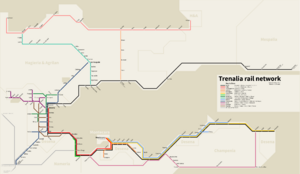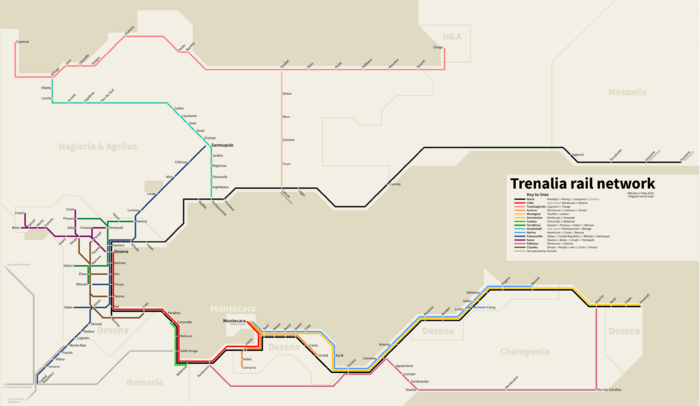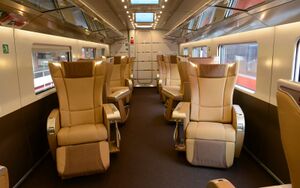User:Montecara/Sandbox 1: Difference between revisions
No edit summary |
No edit summary |
||
| Line 1: | Line 1: | ||
{{ | {{Infobox rail | ||
| | |railroad_name = Trenalia | ||
| | |logo = File:Trenalia-logo.png | ||
| | |logo_size = 300px | ||
| | |logo_alt = Logo of Trenalia | ||
| | |system_map = Trenalia-map.png | ||
| | |map_caption = Network map | ||
|map_size = 300px | |||
|map_alt = | |||
|image = | |||
|image_size = | |||
|image_caption = | |||
|image_alt = | |||
|marks = TNA | |||
|locale = Southeastern [[Conitia]] | |||
|start_year = {{Start date|1955}} | |||
|end_year = present | |||
|predecessor_line = | |||
|successor_line = | |||
|gauge = 1,500 mm | |||
|old_gauge = <!-- This needs a separate line --> | |||
|electrification = 25 {{wp|kV}} / 50 {{wp|Hz}} {{wp|Alternating current|AC}} | |||
|length = | |||
|hq_city = [[Montecara]] | |||
|website = [http://trenalia.co trenalia.co] | |||
}} | |||
'''Trenalia''' is an international passenger rail and rail services company serving southeastern [[Euclea]]. It is jointly owned by the governments of [[Montecara]] and [[Florena]] and offers extensive services in those countries along with connecting services to [[Gaullica]] and [[Etruria]]. The company's headquarters are located directly adjacent to [[Montecara Pòrta Conìxia railway station]]. | |||
== History and ownership == | |||
Rail transport had been a key component of the inter-city transport system in southeast [[Euclea]] since the heyday of steam trains in the mid- to late 19th century. By the 1950s, however, long-distance rail in Florena was in tatters. The country had emerged from the [[Great War (Kylaris)|Great War]] and [[Solarian War]] with badly damaged infrastructure and no surviving rail companies with enough human, material, and financial resources to rebuild. | |||
A solution presented itself in the form of Florena's island neighbor to the east, [[Montecara]]. Montecara had longed for a fixed link with the Euclean mainland for centuries, but by the time that technology had advanced to the point that such a feat could even be seriously considered, Florena was a war-ravaged and poor nation that the Montecaran government wanted to keep at arm's length. With Florena in recovery by the early 1950s, though, it seemed that the time had finally come for the two countries to collaborate. The two states signed a memorandum of understanding in May 1951 to work together to rebuild and connect their rail systems. After four years of negotiations, '''Trenalia''' was born as a joint government-owned corporation in 1955, with its stock split 50-50 between the two states. It was agreed that the company would have a legal monopoly on long-distance and regional rail services, and that the state governments would guarantee debt coverage in the event of budget shortfalls. Private freight rail companies continued to operate, and Gaullican and Etrurian trains connected to destinations in Florena, but Trenalia was the sole provider of domestic and cross-border passenger rail in its service area. | |||
Trenalia began passenger operations on 7 March 1955 an inaugural service between [[Demora]] and [[Montecara]] that used a rail ferry to cross the [[Aurean Straits]]. Engineering studies began the following year to explore the various possibilities for a cross-strait link that would drastically ease travel between Montecara and the Euclean mainland. | |||
== Divisions and subsidiaries == | |||
Trenalia is organized primarily into two operating divisions: '''Trenalia Nord''' and '''Trenalia Sud'''. These divisions are separated by the [[Lazarene Sea]] and are not connected to each other. Rolling stock and other equipment must be ferried across the sea as needed. | |||
In addition to its core passenger-rail business, Trenalia operates a number of subsidiaries that cover other aspects of the rail transport industry. '''Trenalia Cargo''' conducts {{wp|freight rail}} operations and '''Trenalia Infra''' manages the construction and maintenance of rail infrastructure. | |||
== Routes and lines == | |||
[[File:Trenalia-map.png|700px|thumbnail|Trenalia route map]] | |||
Trenalia services include high-speed, higher-speed, and conventional-speed rail. Night trains (except for high-speed services) often operate with attached {{wp|sleeping cars}} which are detached when they reach their intended destination in the morning. | |||
Trenalia organizes its services into the following lines: | |||
{| class="wikitable" style="width: 100%" | |||
|- | |||
! Line | |||
! Type | |||
! Termini | |||
|- | |||
| style="background: black; color: white;" |'''Nerea''' | |||
| {{wp|Inter-city rail}} | |||
| Amarești/Alunișu — Iouzzene (Pochiainen) | |||
|- | |||
| style="background: red; color: white;" |'''Iridia''' | |||
| {{wp|High-speed rail}} | |||
| Montecara — Desena | |||
|- | |||
| style="background: lightsalmon; color: white;" |'''Transhagierien''' | |||
| Inter-city rail | |||
| Cypresse — Tienge | |||
|- | |||
| style="background: orangered; color: white;" |'''Saciuva''' | |||
| Inter-city rail | |||
| Montecara — Campina/Gristol | |||
|- | |||
| style="background: sandybrown; color: white;" |'''Montagnes''' | |||
| Inter-city rail | |||
| Touillet — Latium | |||
|- | |||
| style="background: gold; color: white;" |'''Serenissima''' | |||
| {{wp|Higher-speed rail}} | |||
| Montecara — Valisoara | |||
|- | |||
| style="background: limegreen; color: white;" |'''Costera''' | |||
| Inter-city rail | |||
| Concordia — Bellerose | |||
|- | |||
| style="background: green; color: white;" |'''Terrafirma''' | |||
| Inter-city rail | |||
| Veseud/Presaca — Videni/Milovan | |||
|- | |||
| style="background: teal; color: white;" |'''Grandcitadi''' | |||
| High-speed rail | |||
| Porteauriente — Béliage | |||
|- | |||
| style="background: deepskyblue; color: white;" |'''Marina''' | |||
| Inter-city rail | |||
| Montecara — Bacova | |||
|- | |||
| style="background: blue; color: white;" |'''Transconitia''' | |||
| Inter-city rail | |||
| Sabas/Ciudad República/Milovan — Santeupul | |||
|- | |||
| style="background: purple; color: white;" |'''Suran''' | |||
| Inter-city rail | |||
| Desena — Brelu/Linești/Timeșesti | |||
|- | |||
| style="background: orchid; color: white;" |'''Palmiera''' | |||
| Inter-city rail | |||
| Portonovo — Osoríos | |||
|- | |||
| style="background: saddlebrown; color: white;" |'''Cisardes''' | |||
| Inter-city rail | |||
| Devan/Perești/Aris — Cven/Terona | |||
|} | |||
== Classes of service == | |||
[[File:Trenalia-seats1.jpeg|300px|thumb|First-class seating on Ultra service]] | |||
[[File:SJ X3 (X3000) interior.jpg|300px|thumbnail|Second-class seating on Exprima service]] | |||
=== First class === | |||
All first-class tickets come with access to first-class waiting rooms at stations where available. Aboard the train, first-class passengers enjoy complimentary snacks and drinks, newspapers and magazines, and access to dedicated lounge and dining cars and meeting rooms on select trains. | |||
==== Seating ==== | |||
Trenalia uses several different seating configurations in its carriages. On trains with open-carriage seating, first-class seats are arranged three to a row and generally face forward aside from a few sets of two or four facing each other at the ends of carriages. | |||
On trains with compartment seating, first-class compartments seat four, arranged in two pairs of seats facing each other. | |||
All first-class seats come with a table, reading lamp, and attendant call button. | |||
==== Single sleeper ==== | |||
A private room for a single traveler, first-class single sleepers come with a private toilet, shower, and sink. The bed converts to a couch and table for daytime use, and an attendant is on call to bring meals, drinks, and snacks and provide turndown service. | |||
==== Double sleeper ==== | |||
First-class double sleepers accommodate two and may be booked whole or by a single traveler, in which case they are single-sex. Like the single sleepers, they come with private toilet, shower, and sink, and an attendant is on call to bring meals, drinks, and snacks and provide turndown service. | |||
=== Second class === | |||
| | [[File:Trenalia-double2.jpeg|300px|thumbnail|A second-class double compartment configured for nighttime]] | ||
==== Seating ==== | |||
Second-class seats are slightly narrower than first-class ones, with four seats per row rather than three in open carriages and pairs of three seats each in compartment carriages. They are generally equipped with folding tray tables. Drinks, snacks, and meals are available for purchase in the bar or dining car. | |||
==== Double sleeper ==== | |||
Second-class double compartments can be booked whole or by a single traveler, in which case they are single-sex. They have a private sink and share toilets with the rest of the carriage. | |||
==== Quartet ==== | |||
{{wp|Couchette car}} with space for four travelers per compartment. They are usually mixed-sex, but trains generally have at least one women's-only quartet, and groups may reserve the entire compartment. They have a private sink and share toilets with the rest of the carriage. | |||
=== Reservations === | |||
| | [[File:Second class seat number plate on CR400AF-A-2066 (20181024185530).jpg|thumb|250px|Lights above a row of second-class seats indicating that seat 3C is reserved]] | ||
Reservations are required for single sleepers but are optional for all other tickets. Reserving a seat incurs a small additional charge. | |||
== Fares and ticketing == | |||
Commuter services are priced transparently based on distance traveled. This means that tickets can be purchased well in advance and used at any time by simply validating the ticket before boarding. | |||
For intercity services, Trenalia uses a complex fare structure based on distance, date and time, service class, train type, how far in advance the ticket is booked, and other factors. | |||
'''Cartalia''' is Trenalia's discount card, available in three versions: Cartalia25, Cartalia50, and Cartalia100. The first two offer discounts of 25% and 50% respectively on all tickets; the last allows for unlimited travel on the entire rail network excluding sleepers, which require a small additional payment. | |||
Revision as of 19:28, 6 January 2020
 | |
 Network map | |
| Reporting mark | TNA |
|---|---|
| Locale | Southeastern Conitia |
| Dates of operation | 1955–present |
| Track gauge | 1,500 mm |
| Electrification | 25 kV / 50 Hz AC |
| Headquarters | Montecara |
| Website | trenalia.co |
Trenalia is an international passenger rail and rail services company serving southeastern Euclea. It is jointly owned by the governments of Montecara and Florena and offers extensive services in those countries along with connecting services to Gaullica and Etruria. The company's headquarters are located directly adjacent to Montecara Pòrta Conìxia railway station.
History and ownership
Rail transport had been a key component of the inter-city transport system in southeast Euclea since the heyday of steam trains in the mid- to late 19th century. By the 1950s, however, long-distance rail in Florena was in tatters. The country had emerged from the Great War and Solarian War with badly damaged infrastructure and no surviving rail companies with enough human, material, and financial resources to rebuild.
A solution presented itself in the form of Florena's island neighbor to the east, Montecara. Montecara had longed for a fixed link with the Euclean mainland for centuries, but by the time that technology had advanced to the point that such a feat could even be seriously considered, Florena was a war-ravaged and poor nation that the Montecaran government wanted to keep at arm's length. With Florena in recovery by the early 1950s, though, it seemed that the time had finally come for the two countries to collaborate. The two states signed a memorandum of understanding in May 1951 to work together to rebuild and connect their rail systems. After four years of negotiations, Trenalia was born as a joint government-owned corporation in 1955, with its stock split 50-50 between the two states. It was agreed that the company would have a legal monopoly on long-distance and regional rail services, and that the state governments would guarantee debt coverage in the event of budget shortfalls. Private freight rail companies continued to operate, and Gaullican and Etrurian trains connected to destinations in Florena, but Trenalia was the sole provider of domestic and cross-border passenger rail in its service area.
Trenalia began passenger operations on 7 March 1955 an inaugural service between Demora and Montecara that used a rail ferry to cross the Aurean Straits. Engineering studies began the following year to explore the various possibilities for a cross-strait link that would drastically ease travel between Montecara and the Euclean mainland.
Divisions and subsidiaries
Trenalia is organized primarily into two operating divisions: Trenalia Nord and Trenalia Sud. These divisions are separated by the Lazarene Sea and are not connected to each other. Rolling stock and other equipment must be ferried across the sea as needed.
In addition to its core passenger-rail business, Trenalia operates a number of subsidiaries that cover other aspects of the rail transport industry. Trenalia Cargo conducts freight rail operations and Trenalia Infra manages the construction and maintenance of rail infrastructure.
Routes and lines
Trenalia services include high-speed, higher-speed, and conventional-speed rail. Night trains (except for high-speed services) often operate with attached sleeping cars which are detached when they reach their intended destination in the morning.
Trenalia organizes its services into the following lines:
| Line | Type | Termini |
|---|---|---|
| Nerea | Inter-city rail | Amarești/Alunișu — Iouzzene (Pochiainen) |
| Iridia | High-speed rail | Montecara — Desena |
| Transhagierien | Inter-city rail | Cypresse — Tienge |
| Saciuva | Inter-city rail | Montecara — Campina/Gristol |
| Montagnes | Inter-city rail | Touillet — Latium |
| Serenissima | Higher-speed rail | Montecara — Valisoara |
| Costera | Inter-city rail | Concordia — Bellerose |
| Terrafirma | Inter-city rail | Veseud/Presaca — Videni/Milovan |
| Grandcitadi | High-speed rail | Porteauriente — Béliage |
| Marina | Inter-city rail | Montecara — Bacova |
| Transconitia | Inter-city rail | Sabas/Ciudad República/Milovan — Santeupul |
| Suran | Inter-city rail | Desena — Brelu/Linești/Timeșesti |
| Palmiera | Inter-city rail | Portonovo — Osoríos |
| Cisardes | Inter-city rail | Devan/Perești/Aris — Cven/Terona |
Classes of service
First class
All first-class tickets come with access to first-class waiting rooms at stations where available. Aboard the train, first-class passengers enjoy complimentary snacks and drinks, newspapers and magazines, and access to dedicated lounge and dining cars and meeting rooms on select trains.
Seating
Trenalia uses several different seating configurations in its carriages. On trains with open-carriage seating, first-class seats are arranged three to a row and generally face forward aside from a few sets of two or four facing each other at the ends of carriages.
On trains with compartment seating, first-class compartments seat four, arranged in two pairs of seats facing each other.
All first-class seats come with a table, reading lamp, and attendant call button.
Single sleeper
A private room for a single traveler, first-class single sleepers come with a private toilet, shower, and sink. The bed converts to a couch and table for daytime use, and an attendant is on call to bring meals, drinks, and snacks and provide turndown service.
Double sleeper
First-class double sleepers accommodate two and may be booked whole or by a single traveler, in which case they are single-sex. Like the single sleepers, they come with private toilet, shower, and sink, and an attendant is on call to bring meals, drinks, and snacks and provide turndown service.
Second class
Seating
Second-class seats are slightly narrower than first-class ones, with four seats per row rather than three in open carriages and pairs of three seats each in compartment carriages. They are generally equipped with folding tray tables. Drinks, snacks, and meals are available for purchase in the bar or dining car.
Double sleeper
Second-class double compartments can be booked whole or by a single traveler, in which case they are single-sex. They have a private sink and share toilets with the rest of the carriage.
Quartet
Couchette car with space for four travelers per compartment. They are usually mixed-sex, but trains generally have at least one women's-only quartet, and groups may reserve the entire compartment. They have a private sink and share toilets with the rest of the carriage.
Reservations
Reservations are required for single sleepers but are optional for all other tickets. Reserving a seat incurs a small additional charge.
Fares and ticketing
Commuter services are priced transparently based on distance traveled. This means that tickets can be purchased well in advance and used at any time by simply validating the ticket before boarding.
For intercity services, Trenalia uses a complex fare structure based on distance, date and time, service class, train type, how far in advance the ticket is booked, and other factors.
Cartalia is Trenalia's discount card, available in three versions: Cartalia25, Cartalia50, and Cartalia100. The first two offer discounts of 25% and 50% respectively on all tickets; the last allows for unlimited travel on the entire rail network excluding sleepers, which require a small additional payment.




